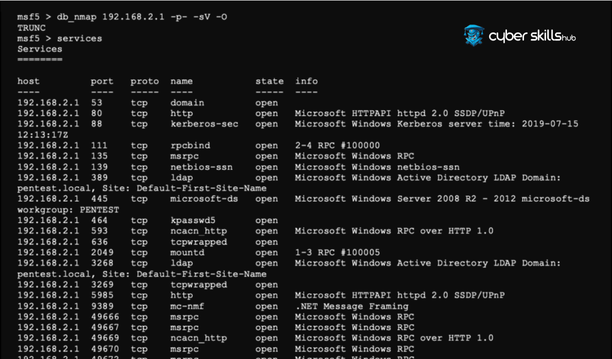Currently Empty: $0.00

A cyber security expert plans to overcome the enemy’s defenses by discovering the enemy’s weak points. They need powerful and flexible tools in this discovery process, and that’s where Metasploit comes in, because this platform has become a standard in the pen testing field.
What is Metasploit?
Metasploit is a tool that allows cyber security professionals to discover vulnerabilities, facilitate exploit writing and test vulnerabilities; it has an open source and modular structure. Metasploit’s potential attack surfaces you can review this article to learn how to expand it.
Basic Definition of Metasploit
Metasploit is the most popular and comprehensive software used to find, test vulnerabilities in network and computer systems and perform penetration simulations using these vulnerabilities the penetration testing framework is. This advanced toolkit, with both closed and open source versions, is considered a fundamental element in the security world and offers an interactive use that can be customized according to the level of expertise. With its different components such as Exploit modules, utility tools, backdoors and payloads, Metasploit allows you to apply various scenarios and techniques to test each vulnerability.
A Brief History of Metasploit
The Metasploit project was developed in 2003 by H.D. Moore as a vulnerability assessment tool. It spread rapidly with its open-source and diversifiable structure. The project has become a standard reference point in the field of cyber security.
Rapid7 took an important step towards institutionalizing the project by acquiring Metasploit in 2009. This acquisition enabled the platform to reach a wider audience and become widespread among professionals.
Metasploit continues to be one of the most frequently used penetration testing tools worldwide.
With its comprehensive exploit database, regular updates and modular structure, Metasploit offers a powerful and flexible testing environment to security researchers and ethical hackers. At the same time, it also provides automation facilities for security actions, contributing to a more efficient use of experts’ time.
Metasploit’s the red team check out this article to learn in more detail how it is used in tests.
Basic Features and Functions
Metasploit; It has a modular structure.
Thanks to this structure, it adapts to different security needs. Thanks to the rich exploit database, it contains hundreds of ready-made exploits and payloads, provides operational flexibility by adding expandable auxiliary modules during operation. In addition, it offers detailed analysis and control capabilities on the target system with comprehensive post-exploitation modules.
Network scanning and service recognition capabilities are advanced.
It offers features that increase diversity in penetration testing processes, including automatic target detection, intelligent exploit selection and efficient payload injection. An up to date and extensive database is used to identify vulnerabilities of target systems.
In addition to a user-friendly command-line interface and metasploit framework user interfaces that can meet the needs of advanced users, there is also graphical user interface (GUI) support that requires less technical knowledge. The integration possibilities are wide thanks to the scripts used to automate the operations performed from the command line and various API support. Also, if you want to get information about the best tools you can use to test vulnerabilities on mobile platforms, ‘The Best Mobile Pentest Tools 2024 you can check out our article titled‘.
Metasploit Installation Process
The basic installation of Metasploit is quite simple; first of all, the distribution package (metasploit-framework) is installed for the appropriate platform. This can usually be accomplished through the official Metasploit website or the package managers of Linux distributions. System updates and dependency management should be provided after the installation process, so that the necessary environment is prepared for the software to run smoothly.
Following the installation process, the database is initialized and Metasploit services are started via the msfdb init command in order to make it ready for use. Thus, Metasploit’s exploit, auxiliary, payload and other modules are kept up-to-date and performance optimization is ensured. After the installation and startup procedures are completed, you can log in to the metasploit console or, if desired, the web interface and start security tests.

Required System Requirements
In order for Metasploit to work stably and efficiently, it is essential to meet certain system requirements.
- Operating System: Windows, Linux or macOS
- Processor: x86 compatible 2 GHz or faster processor
- Ram: At least 2 GB, but 4 GB or more is recommended
- Disk Space: Minimum 500 MB for additional modules October in addition to installation
- Network: IPv4 and IPv6 support, must be accessible by the network
These conditions are prerequisites for the proper installation and functioning of the Metasploit framework.
These hardware requirements have been kept to a minimum in order for Metasploit to perform maximally in complex test environments. Especially when working with large and dynamic network structures, it will be useful for the system to have stronger resources.
Step by Step Installation Guide
Before starting the installation of Metasploit, make sure that you meet the above mentioned system requirements. The necessary dependencies and tools for installation should be identified as a priority.
Media files or source code related to the installation metasploit.com download it from the address. It is important to choose the appropriate version at this stage.
Then follow the installation instructions by switching to the directory where the downloaded package is located. On Linux-based systems, an easy installation is usually possible using package managers such as “apt” or “yum”. You may need to install custom dependencies manually.
After successfully installing metasploit, the system should be restarted and the metasploit console should be opened to make the necessary configuration settings. During the first run, some database settings may need to be made and plug-ins updated. It is important to check the settings of firewalls and antivirus programs so that they do not interfere with Metasploit processes and correct them when necessary.
Metasploit Usage Scenarios
Metasploit is a flexible tool preferred by cyber security professionals for different purposes. Detection and evaluation of security vulnerabilities is one of the most common areas of use of this tool. For example, a security professional can use Metasploit to find potential vulnerabilities in the system and fix them. Metasploit is an important resource used to detect vulnerable points of computers in the network and apply pen-test (penetration test) to measure the durability of systems. In addition, Metasploit is a very valuable tool for testing the response and effectiveness of existing security solutions. This platform is also frequently used in cyber exercises and trainings by simulating real-world scenarios. In addition, in more advanced scenarios such as custom exploit development and integration or automation of management processes, Metasploit has become a tool that cyber security experts apply to.
Testing Vulnerabilities
Metasploit is used to discover and test the vulnerabilities of systems by realistically simulating cyber attack scenarios.
- Automatic Scanning: To identify potential weaknesses in computer networks quickly and effectively.
- The Exploit Library: Thanks to a large exploit database, it is possible to test a wide variety of system and software vulnerabilities.
- Load Management (Payload Management): Selecting and configuring malware (payload) to be used in attack scenarios.
- Command and Control: Sending and controlling remote commands to the victim system during the testing process.
- Comprehensive Reporting: Creating a detailed report of the findings and vulnerabilities obtained as a result of the tests.
By using these tools systematically, you can strengthen your security posture and increase your measures against vulnerabilities.
In addition to identifying the vulnerabilities of your systems, you can develop proactive defense strategies based on these findings and update your security policies.
Attack Simulations
Metasploit is a powerful tool preferred for detecting security vulnerabilities in complex network structures and simulating them. These simulations allow to understand the systems from the perspective of the attacker and to test the defense mechanisms.
- Creating a Scenario: Designing special attack scenarios and experimenting with them.
- Malware Injection: Infecting target systems with malicious code using customizable payloads.
- Firewall Penetration Tests: Don’t try to bypass active security devices (firewall, IDS/IPS).
- Social Engineering Tactics: Testing security awareness with tactics on users.
- Sensitive Data Access: Evaluating data protection strategies by simulating unauthorized data access.
These mentioned techniques make it possible to understand the attack vectors in a multifaceted way and to shape the defense systems accordingly.
By creating a test environment that is close to reality, Metasploit measures the resilience of systems against cyber attacks and exposes security vulnerabilities. This provides valuable information for organizations to update their current security policies and procedures.

Advanced Metasploit Usage
The Metasploit framework provides a rich set of tools that professional cybersecurity professionals prefer to identify and exploit complex vulnerabilities. Advanced use includes operations that require deep knowledge, such as automated command directories (scripts), post-exploitation modules, customized exploit development, and reconfiguring existing modules. Persistence scripts can be used to provide permanent access on the target system, while exploit chains can be created on more systems with the help of pivot techniques. In addition, timely and effective security audits are performed in large network structures with automation tools (e.g. Ansible, Puppet) that Metasploit can be integrated with. Each of these components is an important tool for testing your system against security breaches and is critical for evaluating how effective defense mechanisms are in real-world scenarios when used correctly.
Custom Modules and Scripts
Custom modules and scripts in Metasploit are written manually during security tests, or existing ones are modified. These scripts are organized according to parameters determined by the user in order to serve customized needs and allow testing of scenarios designed for specific goals.
Such customizations can be used in the simulation of attack vectors specific to a specific network structure or system configuration. In short, it is more complex than the modules available for general use and provides the detailing necessary to be able to counter specific security threats.
Scripts written to facilitate post-exploitation processes are critical for automating many different tasks, such as extending earned privileges, collecting data, or moving within the system. Thanks to this customized flexibility, a cyber security specialist can create real-time and effective responses to various threat scenarios, strengthening the security posture.
Modules and scripts specially developed to control and track malware that complicates the existing security infrastructure have irreplaceable value in actions such as advanced Decryption tests, comprehensive security audits and incident response. While the development of these customized tools provides a more detailed perspective on the detection and correction of security vulnerabilities, it is an indispensable method for the implementation of proactive cybersecurity strategies such as threat hunting.
Automation and Scripting with Metasploit
Metasploit’s powerful scripting capabilities open the doors for security professionals to automate complex transactions. By providing the integration of customizable scripts, functions such as the ability to simulate threats or create penetration test scenarios can be easily performed.
Automation and scripting have a critical place in increasing the speed and efficiency of the exploitation process. Repetitive or time-consuming tasks are automated, providing a great advantage in terms of scalability and granularity in strategic cyberattack testing, bulk data analysis, infiltration experiences. This allows security experts to proactively detect and mitigate vulnerabilities, while at the same time simplifying complex cyber defense maneuvers.
Systematic and reusable scripts adapt to the modular structure of Metasploit, making it possible to offer instantaneous responses to threat vectors and centralize security processes. While contributing to the development of a dynamic defense strategy in the face of an ever-changing cyber threat landscape, it also supports the comprehensive and consistent implementation of critical security controls.
In addition, important operations such as automatic mapping of the attack surface and asset discovery are enabled through scripting; comprehensive and timely critical information is provided to security teams. These procedures provide flexibility in evaluating, measuring and intervention continuity situations before and after the attack, while promoting the development of defense mechanisms. This aspect of security automation increases operational efficiency and contributes to strategic decision-making processes.
Frequently Asked Questions About Metasploit
What is Metasploit?
Metasploit is a penetration testing tool widely known and used among Cyber Security Professionals. This tool is used to perform penetration tests on computer systems, detect security vulnerabilities and learn how vulnerabilities can be exploited. Metasploit has an interface and a set of modules that allow users to perform various attacks on target systems.
What Is Metasploit Used For?
Metasploit is a powerful attack and penetration testing tool for Cyber Security Professionals. Metasploit Framework is used to detect weaknesses in computer systems and perform attacks by targeting these weaknesses. Metasploit comes with many different cyber attack techniques and allows attackers to test target systems, discover weak points and exploit vulnerabilities.
Do hackers use Metasploit?
Metasploit is a tool widely used in the field of cybersecurity to detect and exploit weaknesses of computer systems. Metasploit Framework is a software that includes a set of exploits, payloads and modules. This tool can be used by cybersecurity experts when conducting security tests and detecting security vulnerabilities of systems.
Is Metasploit Legal?
Metasploit is a cybersecurity tool and must be used in a legal manner. If proper permissions and protocols are not followed, unauthorized use by an individual can lead to legal issues. It is important to always act in accordance with the law and ethics.
Is It Metasploit Or Kali Linux?
Metasploit and Kali Linux are two very popular tools in the field of cybersecurity. Kali Linux is a Linux distribution and is used as a platform that includes many Cybersecurity tools. Tools such as Metasploit, the attack programming language Python, are available on Kali Linux.







